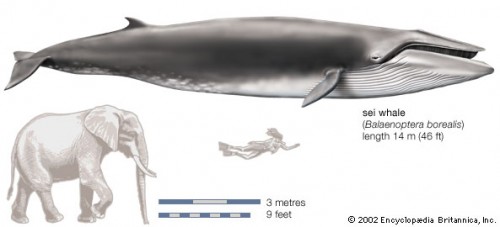Sei Whale
The sei whale is the 3rd largest baleen whale after the fin whale and the blue whale. It inhabits most of the world’s oceans and its adjoining seas, but prefers to stay in deep, offshore waters. It will avoid tropical, polar, and semi-enclosed bodies of water. They migrate annually from the cool and subpolar waters in the summer to the temperate and subtropical waters in the winter. There are two subspecies of sei whales – the northern sei whale and the southern sei whale, but their ranges do not overlap.
As mentioned above, the sei whale is the 3rd largest member of the family Balaenopteridae after the blue and fin whales. Mature adult sei whales measure between 12 – 15 metres long and weigh about 20 to 30 tonnes. The southern sei whale is bigger than its northern sei whale cousin. Females are also much larger than the males. The largest recorded sei whale measured at 20 metres or 66 feet, and weight about 40 to 45 tonnes. The largest specimens found were taken off from Iceland, and were slightly longer than 16 metres. At birth, a sei whale calf usually measures about 4 to 5 metres long.
The sei whale’s body is usually a dark steel grey. However, it also does have some irregular light grey to white markings on its ventral surface or towards the front part of the lower body. The reason for its grey to white markings are due usually due to pits or wounds. When they heal, they become light grey or white. These are thought to be caused by either lampreys or cookie cutter sharks.
Sei whales have between 32 to 60 pleats along the bottom of its body. These pleats allow the throat to greatly expand when it is feeding. It also has a pointed snout, short pectoral fins, and pointed tips. It also has a single ridge that extends from the tip of its snout to its paired blowholes.
These whales usually travel alone, or in groups of up to 6 individuals. Larger groups sometimes assemble but only at feeding grounds that are rather abundant. Other than this, not much is known about their social structure. It is merely thought that males and females bond, but even this is rather uncertain.
Whales are famous for their songs. Sei whales are no exception. They make many loud, long, and low-frequency sounds. Some observers in 2003 described these calls as wooshes or growls. In more technical terms, their calls last for half a second and are within the 240 to 625 hertz range. This is within the range of human hearing. The maximum volume recorded of their vocal sequences is 156 decibels.
The sei whale did not have any meaningful international protection against harpooning until 1970, when the International Whaling Commission (IWC) first set quotas for the North Pacific. Before these quotas, there were no legal limits. Complete protection from commercial whaling came in the North Pacific in 1976. A year later, quotas were set in the North Atlantic, and in 1979 it was protected in the southern hemisphere. With several whale species being threatened with extinction, the IWC stopped commercial whaling in 1986. It is now on the IUCN’s Red List where it is categorized as being endangered. They are also protected in the USA by the U.S. Endangered Species Act.





Photo is wrong.Photo is of Sperm Whale.
The picture at the top is of a sperm whale, not a sei whale. Note the square head, round pectoral fins, and lack of throat pleats.
Photo on the top is wrong. With the square head, round pectoral fins, and lack of throat pleats it is most likely a picture of Revo’s mom. She is actually HUGE.